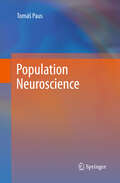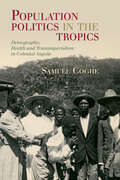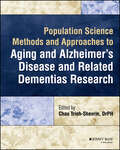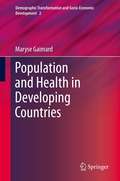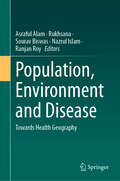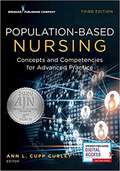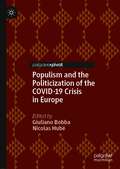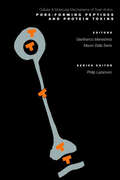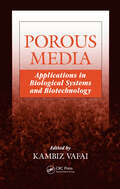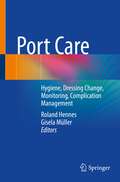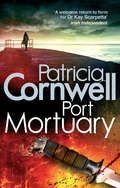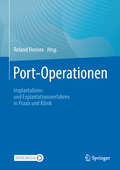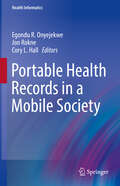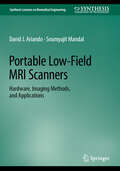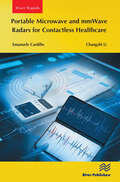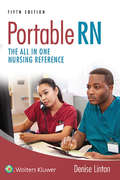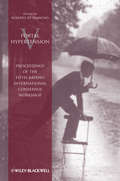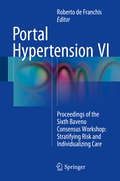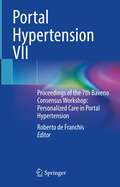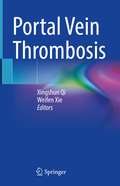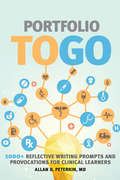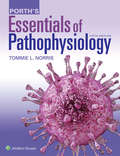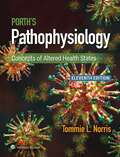- Table View
- List View
Population Neuroscience
by Tomas PausIs Newton's brain different from Rembrandt's? Does a mother's diet during pregnancy impact brain growth? Do adolescent peers leave a signature in the social brain? Does the way we live in our middle years affect how our brains age? To answer these and many other questions, we can now turn to population neuroscience. Population neuroscience endeavors to identify environmental and genetic factors that shape the function and structure of the human brain; it uses the tools and knowledge of genetics (and the "omics" sciences), epidemiology and neuroscience. This text attempts to provide a bridge spanning these three disciplines so that their practitioners can communicate easily with each other when working together on large-scale imaging studies of the developing, mature and aging brain. By understanding the processes driving variations in brain function and structure across individuals, we will also be able to predict an individual's risk of (or resilience against) developing a brain disorder. In the long term, the hope is that population neuroscience will lay the foundation for personalized preventive medicine and, in turn, reduce the burden associated with complex, chronic disorders of brain and body.
Population Politics in the Tropics: Demography, Health and Transimperialism in Colonial Angola (Global Health Histories)
by Samuël CoghePopulation Politics in the Tropics explores colonial population policies in Angola between 1890 and 1945 from a transimperial perspective. Using a wide array of previously unused sources and multilingual archival research from Angola, Portugal and beyond, Samuël Coghe sheds new light on the history of colonial Angola, showing how population policies were conceived, implemented and contested. He analyses why and how doctors, administrators, missionaries and other colonial actors tried to grasp and quantify demographic change and 'improve' the health conditions, reproductive regimes and migration patterns of Angola's 'native' population. Coghe argues that these interventions were inextricably linked to pervasive fears of depopulation and underpopulation, but that their implementation was often hampered by weak state structures, internal conflicts and multiple forms of African agency. Coghe's fresh analysis of demography, health and migration in colonial Angola challenges common ideas of Portuguese colonial exceptionalism.
Population Science Methods and Approaches to Aging and Alzheimer's Disease and Related Dementias Research
by Chau Trinh-ShevrinGain a thorough understanding of the determinants of health among aging populations, how disparities arise in diverse communities, and what can be done Reducing health disparities among older people is critical to slowing or reversing the individual and societal impacts of aging-related conditions like Alzheimer's and dementia. The field of population science can help us understand disparities and prevent them using community-wide strategies. Population Science Methods and Approaches to Aging and Alzheimer's Disease and Related Dementias Research offers an overview of the population health approach, applying this framework to aging-related conditions and their determinants. By working hand-in-hand with diverse communities to address these conditions we can develop primary and secondary prevention strategies that can increase health equity for all Americans. Included topics range from population health trends and approaches to understanding community and patient engagement to caregiver perspectives and emerging trends. Learn about the population science approach to understanding aging-related health concerns in diverse communities See how factors like race, income, sexual orientation, sleep, and community engagement affect Alzheimer's and related dementias Read about proactive approaches to primary and secondary prevention within aging populations Discover emerging research and public health initiatives currently underway to promote health equity Students, researchers, and practitioners alike will benefit from this primer on participatory approaches to reducing health disparities. This introduction to the landscape of aging research in the most vulnerable of our communities will facilitate creativity, compassion, and meaningful next steps in biomedical and socioecological research, community support, and clinical care.
Population and Health in Developing Countries
by Maryse GaimardThis book provides an overview of the health of developing nations in the early twenty-first century. The basic assumption is that the health of a population is not independent of broader demographic trends, and does follow the health transition model. The coverage is broad, ranging from health transition in developing countries, to the health of women, to an analysis of morbidity. Population health is an essential component of human and social development. As both a means and an end of development, health lies at the heart of underdevelopment, and ranks first on the list of international priorities. The WHO slogan 'Health for all in 2000' reflects the spirit of a more general movement in favor of health promotion throughout the world. But the developing world is far from reaching this aim. The health of populations has improved in developing regions but there are still deep inequalities, and serious problems remain, especially in Sub-Saharan Africa. After reviewing the core concepts of population health, the book examines health transition in developing countries, a process that has resulted in a double burden of diseases. A discussion of mortality in developing countries serves to highlight the high rates of child mortality in these regions. The book devotes a full chapter to women's health, and its chapter-length analysis of morbidity highlights the double burden weighing down developing populations and concludes with an analysis of health systems in developing countries.
Population, Environment and Disease: Towards Health Geography
by Ranjan Roy Nazrul Islam Rukhsana Asraful Alam Sourav BiswasThis book discusses a broad range of vital issues in public health, encompassing health facilities, the healthcare system, disease and epidemiological transition of disease, spatio-temporal change of health facilities, disease patterns, and the complex reciprocal relationship between human health and the environment. The book is arranged into three broad sections. Part I: Socio-demographic determinants of public health and policies; Part II: Spatio-temporal & environmental determinants of public health and policies; and Part III: Disease epidemics and challenges. Considering all these overarching themes, this book has been prepared to discuss and provide insights to generate awareness of the holistic perspective of social, cultural, and political factors for public health, disease, epidemics, health facilities, the healthcare system, government policies, prosperity and backdrops in global and local contexts as a geographical perspective. The book should attract the attention of students, researchers, academicians, policymakers and other inquisitive readers interested in different aspects of public health, health geography, and spatial demography.
Population, Sanitation and Health: A Geographical Study Towards Sustainability
by Ranjan Roy Nazrul Islam Rukhsana Asraful Alam Bappa SarkarThis book provides analyses of sanitation, health, population dynamics and demographic variables from different perspectives, including data science, statistics, modeling, economics and natural sciences, to inform sustainable decision making and policies related public health and hygiene and in mainly rural and impoverished areas. The structure is arranged into three broad sections: Part I, Population Dynamics, Environment and Society; Part II, Health, Livelihood and Policy Response; and Part III, Water, Sanitation, and Hygiene (WASH). The book makes recommendations for policymakers on designing and delivering social protection policies to deal with different aspects of water, health, sanitation, population, and hygiene, taking the needs of women and rural communities into special consideration. It also aims to educate students and early career researchers, to help them develop novel approaches for sustainability with environmentally sound practices.
Population-based Nursing: Concepts And Competencies For Advanced Practice
by Ann L. CurleyPraise for the First Edition: “…nicely integrates epidemiological concepts, evidence-based practice in population health, and program development and evaluation...Authors describe epidemiological research designs, research synthesis, and evidence assessment―knowledge essential for advanced practice nurses working with populations or in the community.”―Journal of Community Health Nursing In its third edition, Population-Based Nursing continues to be the only advanced practice nursing text to focus on core competencies in both epidemiology and population health. This comprehensive resource delivers essential content for doctoral nursing practice (as outlined by the AACN) and encompasses the many changes in health care that affect population-based nursing. It describes the role of the advanced practice nurse in identifying and mitigating health care disparities at the local, national, and global levels and provides guidance on how to conduct community assessments. A strong foundation in epidemiologic methodology is provided, including coverage of mortality measures, testing validity and reliability, study designs, risk and casualty assessment, and data analysis and interpretation. Updated throughout, the third edition includes new and expanded topics such as the role of accreditation in validating population-based practice and programs; value-based care; and the use of technology, data, and information systems in population health. The text includes links to online resources and a robust instructor manual with exercises and discussion questions. In addition to its value as a primary textbook in DNP and MSN programs, the text also serves as valuable resource for advanced practice nursing professionals. Key Features: Includes a strong focus on both epidemiology and population-based nursing competencies Addresses the Essentials of Doctoral Education for Advanced Nursing Practice as outlined by the AACN Includes new and expanded topics such as the role of accreditation in validating population-based practice and programs; value-based care; and the use of technology, data, and information systems in population health Examines how technological innovation and social networking impact the development of interventions and population outcomes Provides links to online resources and a robust Instructor Manual with exercises and discussion questions Purchase includes access to the ebook for use on most mobile devices or computers
Populism and the Politicization of the COVID-19 Crisis in Europe
by Giuliano Bobba Nicolas HubéThis edited book provides a first overview of how populist parties responded to the COVID-19 pandemic crisis in Europe. Although populism would normally benefit from crisis situations (e.g., political representation or economic crises), the peculiar nature of this health crisis does not make the benefit obvious. For it to be exploited, a crisis must be politicized. While populists have tried to take advantage of the crisis situation, the impossibility of taking ownership of the COVID-19 issue has made the crisis hard to be exploited. In particular, populists in power have tried to depoliticize the pandemic, whereas radical right-populists in opposition tried to politicize the crisis, though failing to gain the relevant public support. This book considers populist parties in eight European democracies, providing a framework of analysis for their responses to the COVID-19 crisis. It does so by engaging with the literature on crisis and populism from a theoretical perspective and through the lens of the politicization process.
Pore-forming Peptides and Protein Toxins (Cellular and Molecular Mechanisms of Toxic Action)
by Philip Lazarovici Gianfranco Menestrina Mauro Dalla SerraPore-forming proteins and peptides play a central role in bacterial pathogenesis, the immune response, venomous attack, and innate immunity. Pore-forming Peptides and Protein Toxins describes how natural and synthetic peptides and toxins form pores and ionic channels that cause cell membrane collapse and cell death. Written by researchers from around the world, it discusses such topics as the channel-forming properties of Helicobacter pylori and the role of amyloid peptide channels in the development of amyloid diseases. This text provides a multidisciplinary approach to understanding the basic principles and cellular mechanisms of the actions of toxins and their potential use as research tools.
Porous Media: Applications in Biological Systems and Biotechnology
by Kambiz VafaiPresenting state-of-the-art research advancements, Porous Media: Applications in Biological Systems and Biotechnology explores innovative approaches to effectively apply existing porous media technologies to biomedical applications. In each peer-reviewed chapter, world-class scientists and engineers collaborate to address significant problems and d
Port Care: Hygiene, Dressing Change, Monitoring, Complication Management
by Roland Hennes Gisela MüllerComprehensive and professional care for people with ports! This book offers nurses and medical professionals comprehensive knowledge for the care of people with ports. Starting with the selection and indication for port placement, through dressing changes and hygiene guidelines, to everyday handling - here you will find expert knowledge at the highest level! The authors come from different professional groups and show that good interprofessional cooperation is essential for the successful treatment of patients with a port.This book is a translation of the original German 1st edition Portpflege by Roland Hennes and Gisela Müller, published by Springer-Verlag GmbH Germany, part of Springer Nature in 2020. The translation was done with the help of artificial intelligence (machine translation by the service DeepL.com). A subsequent human revision was done primarily in terms of content, so that the book will read stylistically differently from a conventional translation. Springer Nature works continuously to further the development of tools for the production of books and on the related technologies to support the authors.
Port Mortuary (Kay Scarpetta #18)
by Patricia CornwellThe eighteenth book in the Kay Scarpetta series, from No. 1 bestselling author Patricia Cornwell. 'America's most chilling writer of crime fiction' The TimesKay Scarpetta has been training at the Dover Port Mortuary, mastering the art of 'virtual autopsy' - a groundbreaking procedure that could soon revolutionise forensic science. And it is not too long before these new skills urgently need to be put into practice. A young man drops dead, apparently from a heart condition, eerily close to Scarpetta's home. But when his body is examined the next morning, there are stunning indications that he may have been alive when he was zipped inside a pouch and locked in the cooler.When the revolutionary 3D radiology scans reveal more shocking details about internal injuries unlike any Scarpetta has ever seen, she realizes that this is a case of murder - and that she is fighting a cunning and uniquely cruel enemy. Now it is a race against time to discover who and why before more people die. But that time is running out . . .Praise for the groundbreaking series: 'One of the best crime writers writing today' Guardian 'Devilishly clever' Sunday Times 'The top gun in this field' Daily Telegraph 'Forget the pretenders. Cornwell reigns' Mirror 'The Agatha Christie of the DNA age' Express
Port Mortuary (Kay Scarpetta #18)
by Patricia CornwellKay Scarpetta has been training at the Dover Port Mortuary, mastering the art of 'virtual autopsy' - a groundbreaking procedure that could soon revolutionise forensic science. And it is not too long before these new skills urgently need to be put into practice. A young man drops dead, apparently from a heart condition, eerily close to Scarpetta's home. But when his body is examined the next morning, there are stunning indications that he may have been alive when he was zipped inside a pouch and locked inside the cooler.When the revolutionary 3D radiology scans reveal more shocking details about internal injuries unlike any Scarpetta has ever seen, Scarpetta realizes that this is a case of murder - and that she is fighting a cunning and uniquely cruel enemy. Now it is a race against time to discover who and why before more people die. But that time is running out . . .
Port-Operationen: Implantations- und Explantationsverfahren in Praxis und Klinik
by Roland HennesDie Auswahl, Vorbereitung und Durchführung der verschiedenen operativen und interventionellen Verfahren zur Portimplantation und –explantation sind detailliert und praxisnah beschrieben. Dies schließt auch operative Spezialverfahren wie bei Rezidiv-Eingriffen ein. Die Verfahren werden Schritt für Schritt mit zahlreichen Abbildungen dargestellt und zum Teil mit Videos veranschaulicht, die über die SpringerNature MoreMedia-App aufgerufen werden können. Weitere Themen sind die effektive interdisziplinäre Zusammenarbeit mit Anästhesie und Pflege und die wirtschaftlichen Aspekte der ambulanten und stationären Portimplantation. Das Buch wendet sich an alle Ärztinnen und Ärzte, die Porteingriffe durchführen, unabhängig von ihrer Fachrichtung.
Portable Health Records in a Mobile Society (Health Informatics)
by Jon Rokne Egondu R. Onyejekwe Cory L. HallThis book details how electronic health records (EHRs) and medical records (EMRs) can be optimized to enable meaningful interactions between provider and patient to enhance quality of care in this new era of mHealth. As the technologies evolve to provide greater opportunities for mHealth applications, so do the challenges. This book addresses the issues of interoperability limitations, data processing errors and patient data privacy while providing instruction on how blockchain-like processes can potentially ensure the integrity of an externally maintained EHR. Portable Health Records in a Mobile Society identifies important issues and promising solutions to create a truly portable EHRs. It is a valuable resource for all informaticians and healthcare providers seeking an up-to-date resource on how to improve the availability, reliability, integrity and sustainability of these revolutionary developments in healthcare management.
Portable Low-Field MRI Scanners: Hardware, Imaging Methods, and Applications (Synthesis Lectures on Biomedical Engineering)
by Soumyajit Mandal David J. AriandoThis book provides readers with an accessible and up-to-date introduction to the field of low-field MRI, which is currently seeing a resurgence in both research and commercial activity. It begins by presenting a historical overview of MRI system design and discussing current developments. It then analyzes the underlying physics of MRI from a semi-classical perspective before describing the major hardware components of low-field scanners (including the magnet, coils, transmitters, receivers, gradient systems, and digital processors) in detail. Several examples of each component are described to solidify the reader’s understanding of the major challenges and trade-offs involved in designing these complex devices. Finally, the issues involved in integrating these components within a working system are highlighted by presenting the architecture, design, and test results of two fully functional low-field MRI scanners that were designed and developed by the authors.
Portable Microwave and mmWave Radars for Contactless Healthcare
by Emanuele Cardillo Changzhi LiThis book is dedicated to modern radars, describing their working principles and providing an overview on recent applications of microwave and mmWave radars for healthcare applications.For many years, the scientific community has put significant effort into the development of advanced microwave and mmWave radar systems for healthcare applications. Young students, researchers, and professionals need a reference book which clearly and concisely describes the main principles of portable radars and identify the relevant applications of this technology.This book is both an entry point for students and researchers new to the topic and a reference for those seeking to explore specific aspects of radar technologies in healthcare. Ultimately, the authors hope to inspire joint efforts directed towards new innovative theories, technologies, techniques, and applications of modern biomedical radar.
Portable RN: The All-in-one Nursing Reference
by Denise LintonMaster every aspect of day-to-day patient care, with the newly updated Portable RN, 5th Edition. This all-in-one pocket guide to care management offers the latest data and best practices on disorders and treatments, addressing assessments, pre- and post-operative care, drug administration, interpreting lab tests, and more. Ideal for both students and new nurses, this on-the-unit reference guides you to providing top-level care for a variety of patients in a broad range of practice settings.
Portal Hypertension V: Proceedings of the Fifth Baveno International Consensus Workshop
by Roberto De FranchisEvery five years, hepatologists with an interest in portal hypertension (high blood pressure in the portal vein), gather in Baveno, Italy, for the Baveno International Consensus Workshop on Portal Hypertension, attending workshops and examining the latest in clinical data and research on this condition. This book documents the contents of the meeting so that practitioners who could not be present at the conference still have access to the proceedings.
Portal Hypertension VI
by Roberto De FranchisThis book will be an excellent tool for practitioners seeking an update on the latest developments in the diagnosis and management of cirrhosis and portal hypertension. Among the topics addressed are risk stratification, prognosis, screening and surveillance, impact of etiological and antifibrotic therapy, the gut microbiome and cirrhosis, prevention of decompensation/further decompensation, management of the acute bleeding episode, controversies in pediatrics, and vascular diseases of the liver in cirrhotic and noncirrhotic portal hypertension. The book is a compilation of lectures and important consensus statements from the Sixth Baveno International Consensus Workshop on Portal Hypertension, the most recent of a series of workshops held every 5 years for hepatologists with an interest in the field. Portal Hypertension VI will serve as a reference book for clinical and research fellows in Gastroenterology and Hepatology and should inspire new research projects in the areas identified as promising by the experts of the Baveno VI Faculty.
Portal Hypertension VII: Proceedings of the 7th Baveno Consensus Workshop: Personalized Care in Portal Hypertension
by Roberto De FranchisThis book, the seventh in a series of proceedings volumes that began in 1995, reviews the latest developments in the diagnosis and management of cirrhosis and portal hypertension. It addresses a broad range of topics, including: risk stratification, HVPG, non-invasive surrogates for cACLD, CSPH, varices, progression and regression of cirrhosis, impact of etiological therapy on cirrhosis, impact of non-etiological novel therapies on cirrhosis, prevention of first/further decompensation, acute variceal hemorrhage, and Vascular Liver Disorders in Cirrhosis (VALDIG).The book is a compilation of lectures and important consensus statements from the Seventh Baveno International Consensus Workshop on Portal Hypertension, the latest in a series of workshops held every five years for hepatologists with an interest in the field. Portal Hypertension VII offers a valuable reference guide for clinical and research fellows in Gastroenterology and Hepatology and will inspire new research projects in the promising areas identified by the experts of the Baveno VII Faculty.
Portal Vein Thrombosis
by Xingshun Qi Weifen XieThis book covers major knowledge and recent advance regarding portal vein thrombosis. Portal vein thrombosis, a potentially life-threatening vascular disorder of the liver, refers to the development of thrombosis within main portal vein trunk and intrahepatic portal vein branches with or without splenic and mesenteric veins. In patients with acute portal vein thrombosis, if a thrombus extends into the mesenteric veins, there is a risk of intestinal ischemia and necrosis; in patients with chronic portal vein thrombosis, portal hypertension and its complications develop. The book includes chapters on the topics of epidemiology, risk factors, diagnosis, and prognostic impact, pharmacological, interventional with surgical treatment of this disease. Concepts of early diagnosis of portal vein thrombosis and extensive assessment of its severity are fully introduced. The book is beneficial for physicians to establish standard treatment strategy, for researchers to launch creative clinical and experimental studies.
Portfolio to Go: 1000+ Reflective Writing Prompts and Provocations for Clinical Learners
by Allan D. PeterkinPreparing a learning portfolio has become a mandatory part of the course work in most clinical professions. Students and educators alike sometimes complain that these mandatory assignments become repetitive and uninspired. However, we all need to be able to speak and write clearly as we work with our colleagues, students and those we care for. In Portfolio To Go, Allan D. Peterkin insists that reflective capacity, critical thinking, creative expression, and narrative competence are attributes that should be developed in every health professional - regardless of the discipline or specialty. Trainees will find over 1000 prompts organized under themes highly relevant to students and educators, including those not formally addressed in class, such as coping with uncertainty and ambiguity, team conflict, and resilience through good self-care. Practical tips for writing effectively and for discussing and evaluating narratives in a helpful, respective manner are provided throughout. Peterkin is a pioneer in emphasizing patient-centred, humanistic care and Portfolio To Go will help to train and develop more reflective practitioners.
Porth's Essentials of Pathophysiology: Concepts Of Altered Health States
by Tommie NorrisVital Disease Information for Your Success in Nursing Ready yourself for the realities of professional nursing practice with this proven approach to pathophysiology. Distilling need-to-know disease content in a clear, accessible format, Porth’sEssentials of Pathophysiology offers concise yet complete coverage of how the body works to help you establish the scientific foundation essential to success in your nursing career. Approachable presentation builds understanding from basic to advanced concepts and defines key terms as you progress. “Chunked” content--including Learning Objectives, Key Points boxes, and Summary Concepts sections--highlights critical points for reflection. Full-color illustrations clarify the clinical manifestations of diseases and disease processes. Review Exercises at the end of each chapter test your retention and identify areas for further study. References provide fast, efficient access to normal laboratory values in both conventional and SI units, as well as a comprehensive glossary. Narrated animations referenced by icons in the text and available online enhance your understanding of the most challenging and clinically relevant concepts.
Porth's Pathophysiology: Concepts of Altered Health States
by Tommie L. NorrisTrusted for more than 40 years and updated to reflect today’s nursing challenges, Porth’s Pathophysiology: Concepts of Altered Health States, 11th Edition, continues a legacy of excellence with a comprehensive, nursing-focused approach that instills a mastery of both the physical and psychological aspects of altered health. More approachable and inclusive than ever, this unique text clarifies complex ideas through diverse perspectives, the latest evidence-based information, and engaging in-text features and application exercises.
